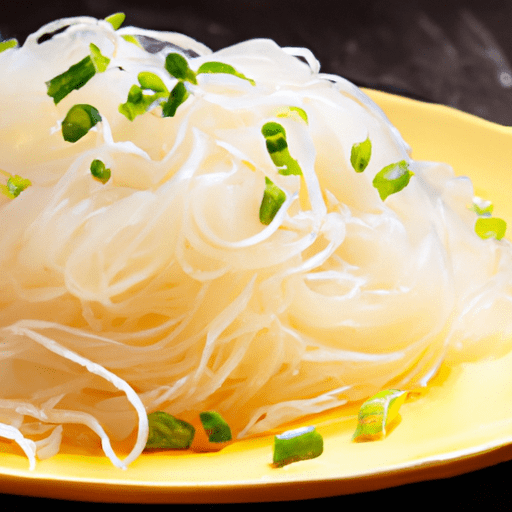Discover the Delightful World of Cooked Glass Noodles
Cooked glass noodles, also known as cellophane noodles or bean thread noodles, are a versatile ingredient prevalent in Asian cuisine. With their translucent appearance and delicate texture, these noodles have gained popularity worldwide for their unique qualities and delicious taste.
In this blog post, we will embark on a culinary journey to explore the wonders of cooked glass noodles. We’ll delve into their taste profile, common uses in cooking, nutritional value, and uncover a few interesting history and facts along the way. So, let’s dive in and discover why these glistening strands are an absolute delight for the taste buds!
Tantalizing Taste Profile
Cooked glass noodles possess a unique taste that is both subtle and delicate. They have a naturally mild flavor, allowing them to absorb the essences of the other ingredients used in a dish. When properly cooked, these noodles become wonderfully soft and chewy, providing a pleasing mouthfeel in every bite.
Versatile Uses in Cooking
Glass noodles are incredibly versatile and can be used in a myriad of dishes, from soups and stir-fries to salads and spring rolls. Here are a few popular dishes where cooked glass noodles truly shine:
1. Japchae - A Korean Stir-Fried Delight
Japchae, a traditional Korean dish, showcases the exquisite qualities of glass noodles. Stir-fried with an array of colorful vegetables, meat (or tofu), and a savory blend of soy sauce and sesame oil, this dish bursts with flavors and textures. Glass noodles add a delightful chewiness and absorb the essence of the accompanying ingredients, creating a harmonious balance.
2. Spring Rolls - Crispy Rolls of Freshness
Glass noodles are often included in the filling of spring rolls, alongside crisp vegetables and protein of choice. Once cooked, these noodles provide a pleasing contrast to the crunchy textures, adding a soft and delightful element to these tasty rolls. The translucent appearance of the noodles also adds an appealing visual aspect to the presentation.
3. Soups and Broths - A Flavorful Addition
Glass noodles have a remarkable ability to absorb the flavors of the broth they are cooked in, making them a popular choice for soups and broths. From Thai-inspired coconut soups to hearty Vietnamese pho, these noodles bring a touch of textural intrigue and soak up the flavorful broth, elevating the overall taste experience.
Nutritional Value
Aside from their delicious taste and versatility in cooking, cooked glass noodles also offer nutritional benefits. These noodles are low in calories and fat, making them a nutritious option for those seeking a lighter alternative to other types of noodles. Additionally, glass noodles are gluten-free and are often made from mung beans, providing a source of protein. They also contain a fair amount of iron, fiber, and other essential vitamins and minerals.
Historical Significance and Interesting Facts
Glass noodles have a rich history that traces back centuries, with their roots in East Asia. They are believed to have originated in China and later spread throughout the region, featuring prominently in the cuisines of Korea, Thailand, Vietnam, and Japan.
The name “glass noodles” was derived from the noodles’ translucent and glass-like appearance. These noodles were traditionally made by mixing mung bean flour or starch with water and then steaming or boiling the mixture until it solidified. The resulting noodles would then be cut into various shapes and sizes, ready to be used in a variety of dishes.
An intriguing fact about glass noodles is that they are often considered a symbol of longevity and good fortune, particularly in Korean culture. As such, they are a popular choice for celebratory occasions like birthdays and weddings.
Conclusion
Cooked glass noodles are a culinary delight that adds a touch of sophistication and versatility to any dish. Their translucent appearance, delicate taste, and ability to absorb flavors make them a wonderful addition to various Asian-inspired recipes. Whether you’re preparing a vibrant stir-fry, wrapping ingredients in spring rolls, or enjoying a comforting bowl of soup, these noodles are sure to elevate your dining experience.
So, the next time you come across a package of cooked glass noodles, don’t hesitate to incorporate them into your culinary repertoire. Embrace their unique qualities and unlock a world of delicious possibilities in your cooking endeavors.
Cooked Glass Noodles
Origin: Glass noodles, also known as cellophane noodles or bean thread noodles, are a type of transparent and gelatinous noodle made from starch such as mung bean, potato, tapioca, or sweet potato. They have been used in Asian cuisine for centuries and are believed to have originated in China.
Common Uses: Cooked glass noodles are a versatile ingredient commonly used in various Asian dishes, particularly in Chinese, Korean, Thai, and Vietnamese cuisine. They are frequently used in stir-fries, soups, salads, and spring rolls. Due to their transparent appearance, they are known for their decorative appeal in dishes.
Nutritional Benefits: Cooked glass noodles are gluten-free and have a low-calorie content. They are a good source of carbohydrates, providing energy. They also contain some dietary fiber and a small amount of protein. Glass noodles are free of cholesterol and fat, making them a suitable choice for those watching their fat intake.
Unique Properties: Glass noodles are translucent and become transparent when cooked. They have a chewy and springy texture with a mild flavor, allowing them to readily absorb the flavors of other ingredients in a dish. They have a long shelf life and a quick cooking time, making them convenient for various culinary preparations.
Historical Significance: Glass noodles have a long history dating back to ancient China. It is believed that they were invented during the Han dynasty (206 BC – 220 AD). Over time, they spread throughout Asia and have become an integral part of many traditional dishes in different countries.




Use the share button below if you liked it.
It makes me smile, when I see it.